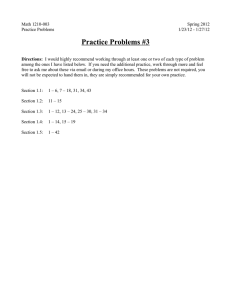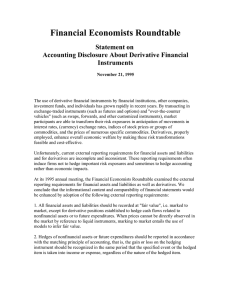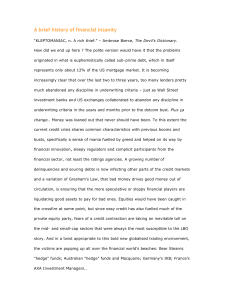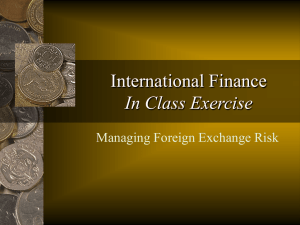Comments Hedge Accounting _8th March 2011_-VK.doc
advertisement
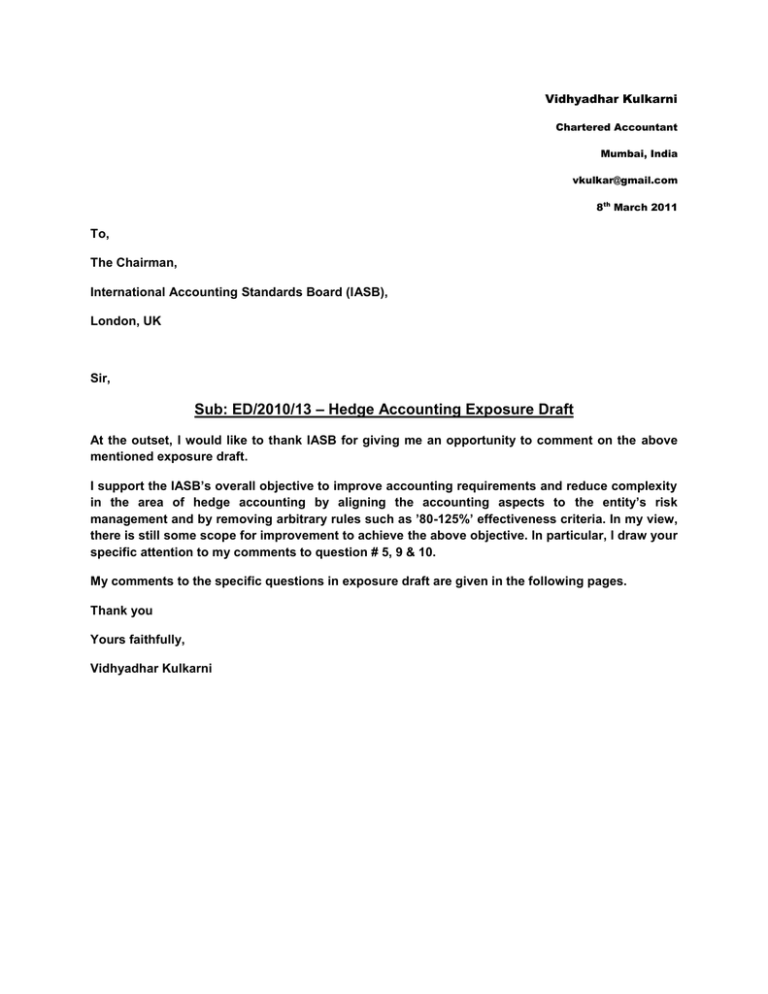
Vidhyadhar Kulkarni Chartered Accountant Mumbai, India vkulkar@gmail.com 8th March 2011 To, The Chairman, International Accounting Standards Board (IASB), London, UK Sir, Sub: ED/2010/13 – Hedge Accounting Exposure Draft At the outset, I would like to thank IASB for giving me an opportunity to comment on the above mentioned exposure draft. I support the IASB’s overall objective to improve accounting requirements and reduce complexity in the area of hedge accounting by aligning the accounting aspects to the entity’s risk management and by removing arbitrary rules such as ’80-125%’ effectiveness criteria. In my view, there is still some scope for improvement to achieve the above objective. In particular, I draw your specific attention to my comments to question # 5, 9 & 10. My comments to the specific questions in exposure draft are given in the following pages. Thank you Yours faithfully, Vidhyadhar Kulkarni Comments on Hedge Accounting Exposure Draft of IASB (8th March 2011) Question 1 Do you agree with the proposed objective of hedge accounting? Why or why not? If not, what changes do you recommend and why? Response: Yes. The proposed objectives of hedge accounting are consistent with the overall ‘underlying principle’ of the IFRS 9 that the accounting for financial instruments should be reflective of the entity’s business model. Question 2 Do you agree that a non-derivative financial asset and a non-derivative financial liability measured at fair value through profit or loss should be eligible hedging instruments? Why or why not? If not, what changes do you recommend and why? Response: Yes. Question 3 Do you agree that an aggregated exposure that is a combination of another exposure and a derivative may be designated as a hedged item? Why or why not? If not, what changes do you recommend and why? Response: Yes. However, the standard should clarify whether there is any maximum cap on the number of derivatives that can be combined with another exposure. Alternatively, current requirements of IAS 39 may be carried forward. Question 4 Do you agree that an entity should be allowed to designate as a hedged item in a hedging relationship changes in the cash flows or fair value of an item attributable to a specific risk or risks (i.e. a risk component), provided that the risk component is separately identifiable and reliably measurable? Why or why not? If not, what changes do you recommend and why? Response: Yes. Question 5 (a) Do you agree that an entity should be allowed to designate a layer of the nominal amount of an item as the hedged item? Why or why not? If not, what changes do you recommend and why? (b) Do you agree that a layer component of a contract that includes a prepayment option should not be eligible as a hedged item in a fair value hedge if the option’s fair value is affected by changes in the hedged risk? Why or why not? If not, what changes do you recommend and why? Response: a)Yes. b)No. It is unclear why the layer component with a prepayment option is ineligible when the standard is proposing to allow combination of an exposure plus a derivative as a hedged item. Further, I would like to state that Application guidance paragraphs B26 & B25 give an impression of the ‘rule’ based narrow prescriptive standard. Excessive emphasis on concepts like ‘Effective Interest Rate’ may result into mis-interpretation and difficulties in applying the standard. The standard should avoid such paragraphs and only retain broad principles such as ‘component of cash flows hedged must be less than or equal to the total cash flows of the asset or liability’. Question 6 Do you agree with the hedge effectiveness requirements as a qualifying criterion for hedge accounting? Why or why not? If not, what do you think the requirements should be? Response: Yes. Question 7 (a) Do you agree that if the hedging relationship fails to meet the objective of the hedge effectiveness assessment an entity should be required to rebalance the hedging relationship, provided that the risk management objective for a hedging relationship remains the same? Why or why not? If not, what changes do you recommend and why? (b) Do you agree that if an entity expects that a designated hedging relationship might fail to meet the objective of the effectiveness assessment in the future, it may also proactively rebalance the hedge relationship? Why or why not? If not, what changes do you recommend and why? Response: a)There should not be mandatory requirement by the standard to rebalance the hedging relationship. The rebalancing, if any, should be driven by the entity’s risk management policy/processes. b)Yes. Entity’s risk management policy may require it to proactively rebalance the hedge relationship. Therefore, it will not be appropriate to restrict that risk management strategy by an accounting standard’s prescription. Comments on Hedge Accounting Exposure Draft of IASB (8th March 2011) Question 8 (a) Do you agree that an entity should discontinue hedge accounting prospectively only when the hedging relationship (or part of a hedging relationship) ceases to meet the qualifying criteria (after taking into account any rebalancing of the hedging relationship, if applicable)? Why or why not? If not, what changes do you recommend and why? (b) Do you agree that an entity should not be permitted to discontinue hedge accounting for a hedging relationship that still meets the risk management objective and strategy on the basis of which it qualified for hedge accounting and that continues to meet all other qualifying criteria? Why or why not? If not, what changes do you recommend and why? Response: a)Yes. Otherwise, discontinuance of hedge accounting ‘at will’, has potential for misuse. b)Yes. Question 9 (a) Do you agree that for a fair value hedge the gain or loss on the hedging instrument and the hedged item should be recognised in other comprehensive income with the ineffective portion of the gain or loss transferred to profit or loss? Why or why not? If not, what changes do you recommend and why? (b) Do you agree that the gain or loss on the hedged item attributable to the hedged risk should be presented as a separate? line item in the statement of financial position? Why or why not? If not, what changes do you recommend and why? (c) Do you agree that linked presentation should not be allowed for fair value hedges? Why or why not? If you disagree, when do you think linked presentation should be allowed and how should it be presented? Response: a)No. This change unnecessarily and artificially increases the number of items recognized in other comprehensive income (OCI) because this new requirement has no real impact on the net amount of gain/loss on fair value hedges recognized in OCI. As I understand, the reason for this change is to present/disclose the ineffective portion of fair value hedge separately. However, this objective can be achieved by simply adding a disclosure requirement to show the ineffective portion of fair value hedges as a separate in Profit or Loss statement instead of shifting the place where this item is rightly recognized. In fact, the IASB should try to reduce the number of recognized in OCI and look at ways to reduce the impact of gains/losses of hedges in OCI. This can be achieved as follows: In case of hedges relating to cash flows or fair values of assets or liabilities recognized in the financial position, the measurement principle of hedging instrument could be aligned with that of the underlying hedged item i.e. if the hedged item is measured at amortized cost then the hedging instrument should also be measured at amortized cost. This principle is exactly the opposite of the current accounting prescription that the hedged item is measured in the same way as the hedging instrument. The current measurement principle of hedge accounting, forces change in the hedged item’s measurement from amortized cost to fair value basis (full or sometimes partial fair value). At times, this requirement poses many complexities in determining fair value of the hedged risk component, hybrid measurement amount which is neither full fair value nor amortized cost (in cases where only a specific risk component is part of hedge relationship). Further, fair valuation of hedging instrument in most such cases does not serve any useful purpose and measurement based on amortized cost principle would be more appropriate. To give examples, fair valuation of interest rate swaps used for hedging interest rate risk of recognized assets/liabilities which otherwise would be measured at amortized cost and periodic fair valuation of Fx Forwards/Fx Futures used to hedge Fx risk of recognized assets/liabilities which otherwise would be measured at amortized cost, does not provide any useful information other than artificial volatility in earnings caused by hypothetical unrealized gains/losses. As regards the information about hedging activities, its impact on entity’s future cash flows etc., the disclosure requirements prescribed are adequate enough to provide the information relevant for users of financial statements. The measurement principle proposed above will undoubtedly reflect the business model of the entity similar to the IFRS 9 accounting principles for classification & measurement of financial instruments. Of course, uniformity and consistency is desirable across financial instruments but may not be appropriate in all situations and across all entities. I am cognizant of the fact that my proposal requires a big change in ‘Mind Set’ that derivatives when used as hedging instruments will not always be measured at fair value. I believe there is merit in changing the mind set if the end result has a better alternative. Having said above, I support fair value measurement & recognition in statement of financial position of hedging instruments relating to unrecognized firm commitments and highly probable forecast transactions until those future transactions result into recognition of an asset/liability in the statement of financial position. Thereafter, accounting prescriptions currently applicable for situations when the forecast transaction subsequently results in recognition of an asset/liability should be made applicable. b)Yes. c)Yes Question 10 (a) Do you agree that for transaction related hedged items, the change in fair value of the option’s time value accumulated in Comments on Hedge Accounting Exposure Draft of IASB (8th March 2011) other comprehensive income should be reclassified in accordance with the general requirements (e.g. like a basis adjustment if capitalised into a non-financial asset or into profit or loss when hedged sales affect profit or loss)? Why or why not? If not, what changes do you recommend and why? (b) Do you agree that for period related hedged items, the part of the aligned time value that relates to the current period should be transferred from accumulated other comprehensive income to profit or loss on a rational basis? Why or why not? If not, what changes do you recommend and why? (c) Do you agree that the accounting for the time value of options should only apply to the extent that the time value relates to the hedged item (ie the ‘aligned time value’ determined using the valuation of an option that would have critical terms that perfectly match the hedged item)? Why or why not? If not, what changes do you recommend and why? Response: a) To c) I do not agree with the proposed standard. The accounting standard’s proposals are adding more complexities and confusions to the measurement principles and may lead to unwarranted addition of new measurement sub-rules or subtypes. My alternative suggestion is that ‘Initial Time value of option’ should be mandatorily segregated and amortized over the tenor of the option and there should not be any subsequent re-measurement or periodic fair valuation of this component of the hedging instrument. Also, I suggest accounting principle proposed for Options should be mandated for other hedging instruments like Fx forward contracts also where intrinsic value and time value can be easily segregated and accounted separately. Question 11 Do you agree with the criteria for the eligibility of groups of items as a hedged item? Why or why not? If not, what changes do you recommend and why? Response: Yes. Question 12 Do you agree that for a hedge of a group of items with offsetting risk positions that affect different line items in the income statement (eg in a net position hedge), any hedging instrument gains or losses recognised in profit or loss should be presented in a separate line from those affected by the hedged items? Why or why not? If not, what changes do you recommend and why? Response: Yes. Question 13 (a) Do you agree with the proposed disclosure requirements? Why or why not? If not, what changes do you recommend and why? (b) What other disclosures do you believe would provide useful information (whether in addition to or instead of the proposed disclosures) and why? Response: Yes. Question 14 Do you agree that if it is in accordance with the entity’s fair value-based risk management strategy derivative accounting would apply to contracts that can be settled net in cash that were entered into and continue to be held for the purpose of the receipt or delivery of a non-financial item in accordance with the entity’s expected purchase, sale or usage requirements? Why or why not? If not, what changes do you recommend and why? Response: Yes. Question 15 (a) Do you agree that all of the three alternative accounting treatments (other than hedge accounting) to account for hedges of credit risk using credit derivatives would add unnecessary complexity to accounting for financial instruments? Why or why not? (b) If not, which of the three alternatives considered by the Board in paragraphs BC226–BC246 should the Board develop further and what changes to that alternative would you recommend and why? Response: Yes. Comments on Hedge Accounting Exposure Draft of IASB (8th March 2011) Question 16 Do you agree with the proposed transition requirements? Why or why not? If not, what changes do you recommend and why? Response: Yes.
